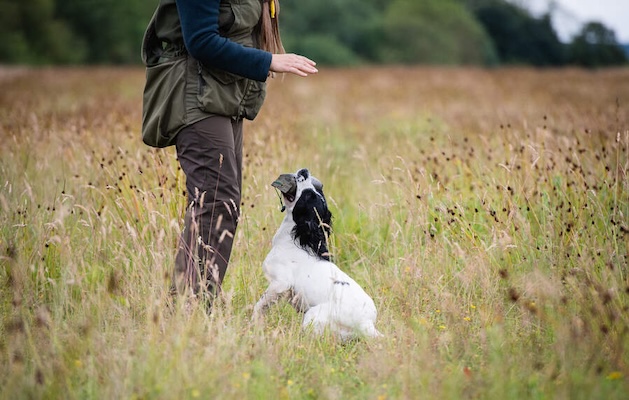Janet Menzies on crime and punishment
Most dog training manuals shy from the word ‘discipline’.
One labrador expert advises his readers to carry rolled-up newspaper with them so they can rattle it over the dog’s head if he misbehaves. Putting this into practice raises several difficulties. Most young gundogs I have tried it with immediately jump up, grab the newspaper and run off with it. (Read more on gundog training theory.)
Loopy theories on dog discipline
Some of the most loopy dog discipline ideas come from experts on peg dog behaviour, rather than working dog-handlers. According to many peg dog trainers, there is no place for punishment, only reward. Others believe that displays of dominance over the dog, such as looking it in the eye, are too threatening and should be avoided.
This ‘he’s only playing’ school of thought has done dogs no good at all. Confronted with this kind of nonsense on one hand and the adolescent dog on the other, most amateurs wisely abandon the no-discipline-at-all ideas immediately. (Read the 10 commandments of gundog training.)
Do not lose your temper
The theory you should never kick your dog is absolutely right. You losing the plot sufficiently to kick out not only shows the dog is comprehensively on top, it also risks inflicting serious internal injuries. The problem for novices is few experts then go on to describe what to do instead.
This is where the practice comes in. If you watch experienced gundog handlers out training their dogs, you will see what they actually do rather than what the books say they do – even those they have written themselves. By far the most common physical punishment used is grabbing the scruff of the neck and delivering a good shaking.
For beginners, the thing to realise is that even professionals need to discipline from time to time, unlike the theory in the books which can leave the first-timer with the impression that he possesses the only thug-dog there is.
When a dog misbehaves
So when do you punish a dog? At the exact moment he misbehaves, chime the books. But surely the whole point is if the novice dog handler was near enough to punish the dog at the time, nothing would have gone wrong in the first place?
The only authority who really comes clean about this Catch-22 is the late Keith Erlandson, one of the most successful spaniel trainers of all. His advice is the instant the dog disobeys, you must run out to him, drag him to the spot where he misbehaved (usually not very far if you are quick enough) and then punish him either with the voice or a shaking.
Seeing this done in practice by a professional dog-handler is as comical as it is impressive. The dog misbehaves and in a nano-second the handler is off like a greyhound, thundering up to the dog and descending on it like the wrath of God.
Even when we have been shown what it takes, few novice dog owners are prepared to put up with the humiliation of a 50yd dash through the heather, especially when they fall over in the process.
Leading professional, Ian Openshaw, rarely finds himself in such an embarrassing position. Instead he prefers to prevent it happening in the first place. If something does go wrong, especially at a moment when he cannot dash in to deliver chastisement, he will simply appear to ignore it. But in the privacy of the home training ground he will replicate the situation. If the dog misbehaves again, now is the time the appropriate telling-off can be done.
Telling a dog off
Deciding the dog needs telling off is as hard a process as sacking one of your staff.
Did the dog actually understand the command it failed to carry out?
Does the dog genuinely know its behaviour is wrong?
Is it reasonable for you to expect the dog to perform the task requested?
Has the dog been subjected to any form of harassment?
In practice, these questions are asked and answered in about the same length of time it takes a mother to decide enough is enough of her two-year-old’s tantrum. You don’t have to have a dog for long to be able to spot the difference between a mickey-take and a genuine failure of communication.
If Bertie answers to his name at feed time, you can expect him to answer to his name when he is meant to be coming back to you. It is fatuous to stand there repeatedly calling, yet it’s the most common fault. Professional trainers are exasperated by this because it is the most basic point of all in dog discipline.
How will you gain your dog’s respect if he knows that he can make you stand around calling like an idiot?
This is the truth the experts dare not tell you in the books: most dogs train their owners rather than the other way round.
Tried and tested tips
Be aware of your dog’s personality and vary your level of discipline to suit.
– Some dogs cower at a harsh word, others wag their tails while being held by the scruff.
With a confident dog you may have to get physical occasionally.
– A shake of his scruff shows you are the boss.
Step in straight away if the dog misbehaves.
– If you can’t get to him fast enough, plan for the next time things go wrong.
Never kick your dog.
– It means you have lost control and can cause internal injuries.
Be consistent.
– Don’t discipline your dog one day and then let him get away with it the next.
Don’t keep calling your dog’s name if he isn’t coming.
– Do something about it.
Don’t put up with your dog’s misdeeds.
– Once you know his failings, work to stop them.
This article was originally published in 2014 and has been updated.





